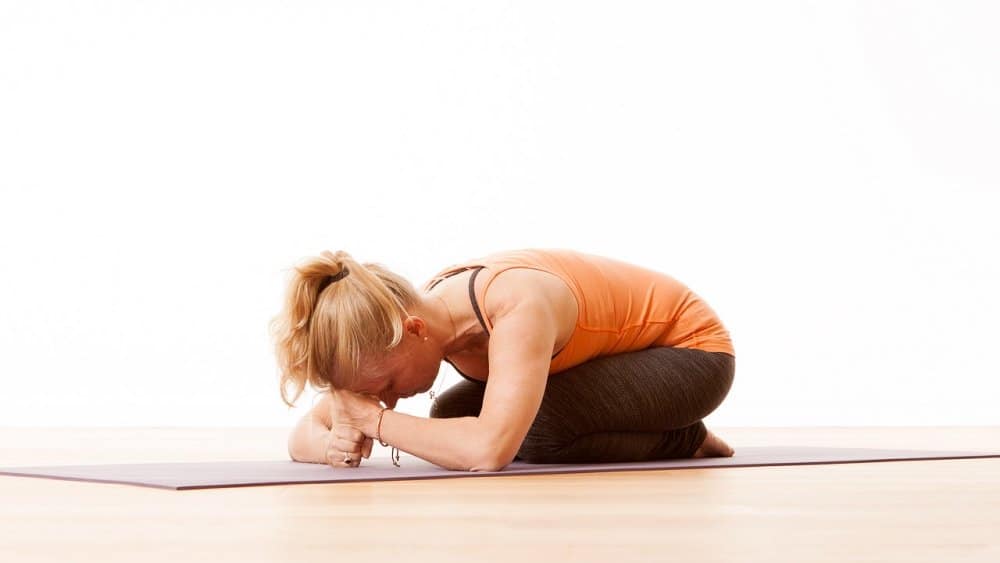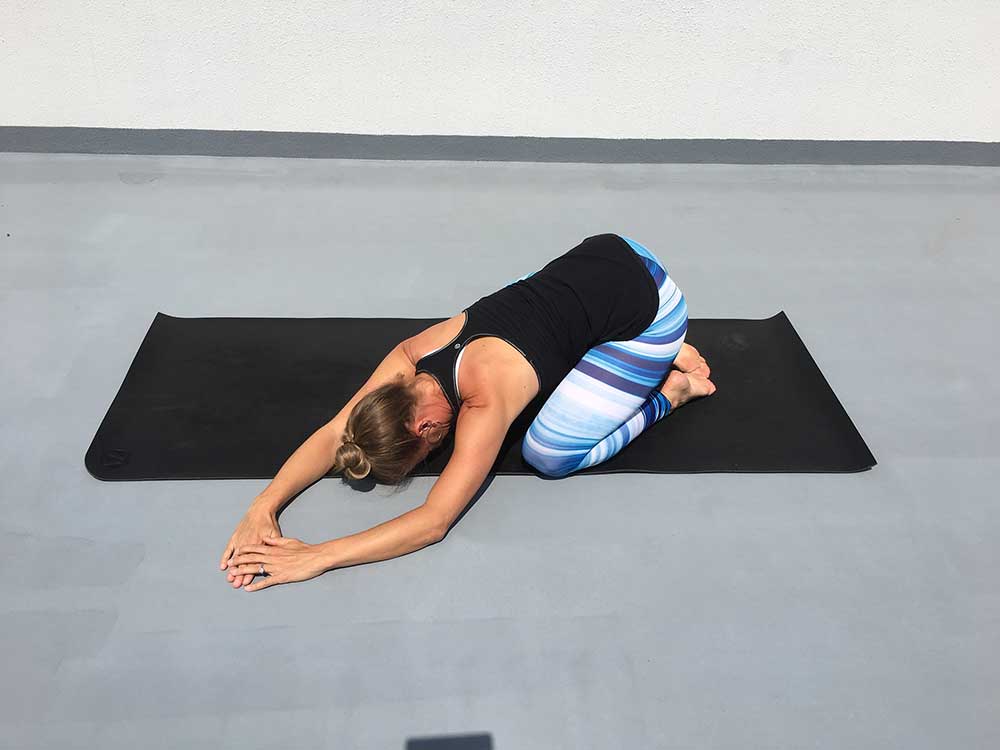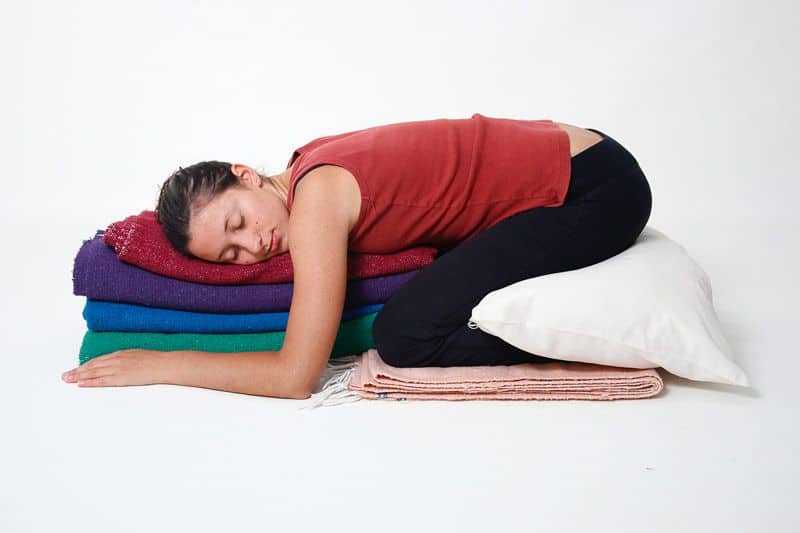The holistic yoga discipline approaches training as a process. So, doing yoga poses is not only about gaining strength and stamina. It also gives you restoration and awakens the self-healing powers of your body.
In certain positions, for example, Child’s Pose (Balasana), the muscle strain is released. So knowing some hacks and Child’s pose adjustments makes this asana an effective but pleasant instrument to restore.
We’ve put together some Balasana modifications you may not be familiar with. So, if you’re curious enough, let’s go.
Some Basic Alignments for the Child’s Pose
Relax, as there is no predetermined time for practicing it!
Whenever you feel like taking a break between the poses in the sequence you’re doing, help yourself with Child’s pose.
Some yogis make jokes about it, but you can even do Child’s pose when you’re off the mat: at the store or after a harsh argument with your partner.
This pose brings you back to the lost inside balance, gives you space to feel safe and present.
But, of course, you should perform it correctly and keep the right body form. You’ll find the precise Balasana instruction in one of our previous posts here. A few things to keep in mind:
- First, your legs, heels, and knees. Press the tops of your feet to the mat, put knees slightly apart ( around 2-3 inches, if you’ve got a belly – you will need more space between your knees). Big toes touch each other and form a V-shaped figure with your knees.
- Second, your hips. Your hips should be properly grounded on your heels. Take some time to find a good connection and feeling you are really sitting on your pelvis. After you lie down, make sure your hips don’t go up. That’s important for the lower back.
The entire process should be done very gently, without any kind of rush.
5 Variations of Balasana
Here are Child’s pose variations that can relieve specific physical problems and unwind really fast.
Child’s Pose to Cure Headache Pain

Adding a bolster (cushion, pillow, or quilt) under the forehead can alleviate headaches. Tension in the neck and upper back region usually serves as the prime cause of headaches and doing this can effectively reduce it.
- Kneel on the ground, behind a large bolster ( or your fists) placed horizontally.
- Lean forward, lengthening your torso and placing your forehead on the bolster.
- The last step is folding your hand in a relaxing manner and freeing your neck, jaw, and shoulders. Being comfortable is all that is required.
- While breaking out of it, you remember to sit up slowly and raise your head at the end. This will help prevent dizziness as you rise from the pose.
Child’s Pose for Side Stretch

In this variation, all you have to do is just change the positioning of the arms, to have a comforting side muscle stretch.
- Get into classic Child’s Pose,
- Then outstretch the left arm from the left-hand side of the mat.
- Then the right arm should be extended and brought to the left as well. Place both arms close to each other.
- The hands need to be pushed on the left-hand side of the ground.
- If you want more, push hips slowly and tenderly to the right for stretching the entire right side.
- Go back to the center and repeat on the other side.
However, there is an advanced form of this asana known as the hands-on adjustment.
Which Yoga Is Best For Lower Back Pain?
Hands-on adjustment (optional): You can either do it for someone else or someone can do it for you, i.e, two people are required for it.
- Stand behind the person and place your left hand on his/her left shoulder for adjusting.
- Hold the outer edge of his/her right hip with your right hand.
- Then very slowly and gently massage his/her shoulder in one direction and hip in the opposite direction.
It is advisable not to try this if you are a beginner. You must do it if and only if you have proper knowledge of safe and gentle methods of hands-on adjustments.
Child’s Pose For Lower Back Pain (Off the Floor Option)

This variation is extremely useful for those who have knee problems and want to avoid bending.
- Stand somewhere you get support for your torso. You can use two chairs: sit on one and the other one will be used for support.
- Then bend your hip joints forward, resting your entire upper body on a platform.
- For breaking out of it, keep your hands on the platform and walk backward maintaining balance and the upper body leaning forward.
- Then fold your knees and slowly get up but keep your back flat.
Child’s Pose For Reducing Tension in Upper Back

In the case of strain in the trapezius, rhomboid, or shoulders, this particular variation can provide to be highly effective.
Do these:
- Begin in Table-top position, then place your arms slightly ahead of your shoulders.
- The arms should be straight and the elbows should be extended and free.
- The hips should be leaning towards the heels and the buttocks higher than usual.
Relaxing or Restorative Child’s Pose
The previous asana proved very effective in stress reduction. But some people face difficulty due to limited shoulder or knee flexibility. In that case, you can go for a more relaxing version of it. You have to do the same asana, but by placing a bolster in the space between your body and the ground. Feel free to totally relax the muscles and let the prop support your tired body.
This pose is ok to hold for a more extended time. The longer you stay in it, the deeper the relaxation will come through. Within 3-10 minutes, the tension in the fascia can be released. Here you can experience some tingling in the muscles. As long as it feels comfortable and not painful – you can stay in the pose.
Before You Go,
Check what else can you get from Child’s pose practice. The asana benefits are as follows:
- The effective stretch of the contracted muscles of the neck or the back of the body, which will be gentle and comforting if you’re not up for intensive training.
- Stress removal. Plus, reduced everyday anxiety thanks to the relaxing effect and lowering cortisol levels after a tough day.
- Child pose helps relieve fatigue within less than 5 minutes.
- Muscle soreness and migraines caused by muscle tension will go away after the Child’s Pose.
With that said, don’t wait too long to try any of the above Child’s Pose modifications, and let’s see which one becomes your favorite.